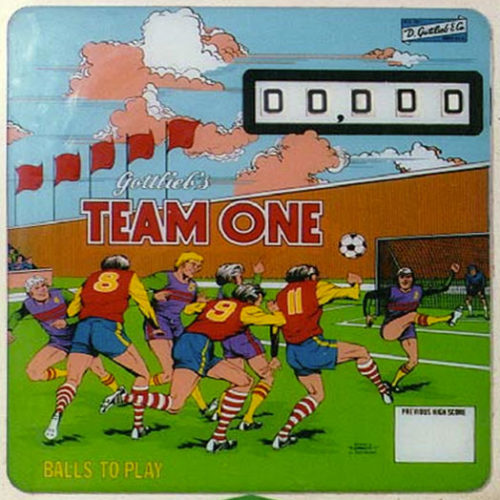-
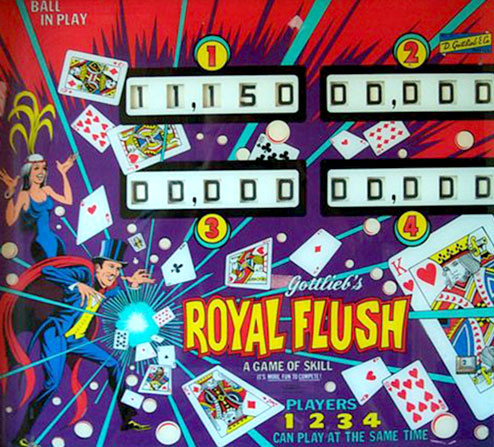 This April release came in a four-player version, also in the museum called “Royal Flush.” 12,250 games were created in this sizable run of machines. Ed Krynski designed the machine with Gordon Morison penning the artwork for the game. A very popular game in its day, the main ingredient of the play field is the battery of nine drop targets set at an angle. The object here is to complete the drop targets to complete the five card combinations represented on the front play field. Completing a combo illuminates the light in the bonus column of combos and at the end of the ball, a “scan” bonus would score the appropriate number of points to the player currently up. The drop targets reset after each ball unless an extra ball is scored via the free ball gate. A double scan of the bonus lights on the last ball. Another feature to shoot for is the three colored card sequence. These light a special on the kick-out hole.
This April release came in a four-player version, also in the museum called “Royal Flush.” 12,250 games were created in this sizable run of machines. Ed Krynski designed the machine with Gordon Morison penning the artwork for the game. A very popular game in its day, the main ingredient of the play field is the battery of nine drop targets set at an angle. The object here is to complete the drop targets to complete the five card combinations represented on the front play field. Completing a combo illuminates the light in the bonus column of combos and at the end of the ball, a “scan” bonus would score the appropriate number of points to the player currently up. The drop targets reset after each ball unless an extra ball is scored via the free ball gate. A double scan of the bonus lights on the last ball. Another feature to shoot for is the three colored card sequence. These light a special on the kick-out hole. -
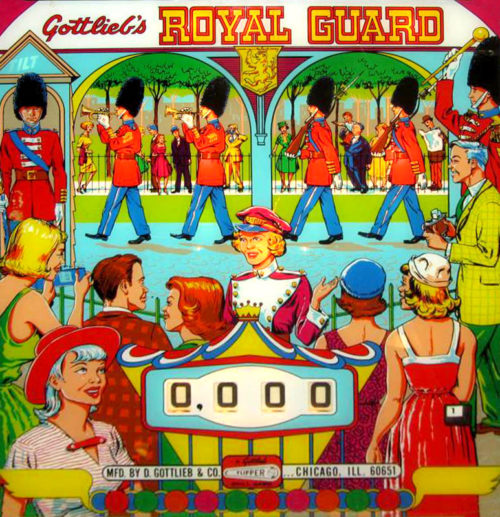
-
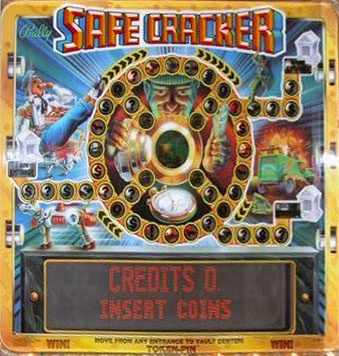 Safecracker is a pinball machine with a safecracking theme, designed by Pat Lawlor, and distributed by Midway (under the Bally label). It was created in 1996. About 1148 were manufactured. Safecracker differs from a standard pinball game in that the player is playing against the clock as opposed to having a certain number of balls available. If the player loses a ball, as long as there is time left on the clock they can continue playing. The machine is smaller in size than a standard pinball machine. The main objective of the game is to break into the bank’s safe. The game can be broken into 3 areas of play: The pinball playfield has numerous targets, the completion of which will allow entry into the bank via the rooftop, the cellar, or the front door. Once the player has entered the bank, the game changes to a boardgame that takes place on the backglass. Using the flipper buttons to make choices, the player rolls dice and moves their piece around the board while being chased by the security guard. The object of this portion of the game is to advance to the center of the game board (where the safe is located) before being caught by the guard. If the player is successful, the game will eject a “magic token” from the bank vault for the player to catch as it rolls down the playfield glass. After the player is done with the regular game, they can deposit their “magic token” into the token slot of the machine to activate a special game mode called “Assault on the Vault”. In this frenzied 4-ball multiball mode, players have 90 seconds to hit as many drop target and ramp shots as possible to break into the bank vault.
Safecracker is a pinball machine with a safecracking theme, designed by Pat Lawlor, and distributed by Midway (under the Bally label). It was created in 1996. About 1148 were manufactured. Safecracker differs from a standard pinball game in that the player is playing against the clock as opposed to having a certain number of balls available. If the player loses a ball, as long as there is time left on the clock they can continue playing. The machine is smaller in size than a standard pinball machine. The main objective of the game is to break into the bank’s safe. The game can be broken into 3 areas of play: The pinball playfield has numerous targets, the completion of which will allow entry into the bank via the rooftop, the cellar, or the front door. Once the player has entered the bank, the game changes to a boardgame that takes place on the backglass. Using the flipper buttons to make choices, the player rolls dice and moves their piece around the board while being chased by the security guard. The object of this portion of the game is to advance to the center of the game board (where the safe is located) before being caught by the guard. If the player is successful, the game will eject a “magic token” from the bank vault for the player to catch as it rolls down the playfield glass. After the player is done with the regular game, they can deposit their “magic token” into the token slot of the machine to activate a special game mode called “Assault on the Vault”. In this frenzied 4-ball multiball mode, players have 90 seconds to hit as many drop target and ramp shots as possible to break into the bank vault. -
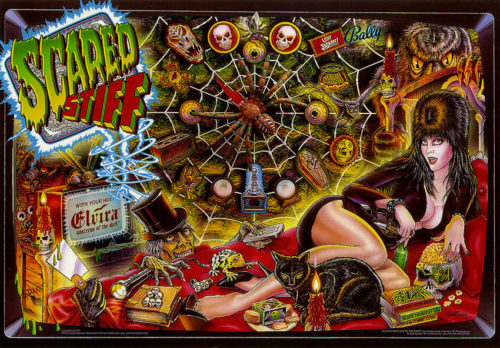 This macabre machine was also one of the most risque games ever made. The vocals are very suggestive as well as the theme of the game. The factory installed a family mode version to the game as well as a cover to the large breasts presented by Elvira on the back glass. Designed by Dennis Nordman and Mark Weyna, the art package came out of the mind of Greg Freres. The object of the game is to complete the six modes represented on the bottom of the playfield. Once all six modes are complete, the object then is to shoot the jackpots with two balls in play all the way up the stiff-o-meter. Doing so produces a pinball fireworks show of light as well as the flippers activating by themselves. The hardest feature on the game is represented in the back glass. If you can achieve all lights by stopping the spider on each and every stop displayed, a special spider multiball is activated. Happy Halloween!
This macabre machine was also one of the most risque games ever made. The vocals are very suggestive as well as the theme of the game. The factory installed a family mode version to the game as well as a cover to the large breasts presented by Elvira on the back glass. Designed by Dennis Nordman and Mark Weyna, the art package came out of the mind of Greg Freres. The object of the game is to complete the six modes represented on the bottom of the playfield. Once all six modes are complete, the object then is to shoot the jackpots with two balls in play all the way up the stiff-o-meter. Doing so produces a pinball fireworks show of light as well as the flippers activating by themselves. The hardest feature on the game is represented in the back glass. If you can achieve all lights by stopping the spider on each and every stop displayed, a special spider multiball is activated. Happy Halloween! -
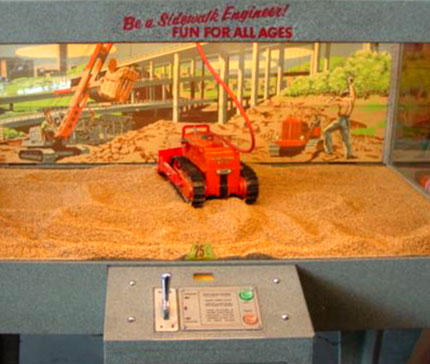 This Williams machine fabricated in 1955 is a strange game that really is more of a toy. A player gets to operate a remote-controlled bulldozer around a big sandbox for 120 seconds using two remote controllers in synthetic gravel. It appears the idea for this machine was to cater to the under-12 market as no rewards, extra time, or extra plays were programmed into the electromechanical boards within the machine. No scoring and no prizes! This machine was often confused with Williams’ Crane (1956) because it has a sign on top of the game that says, “Be a sidewalk engineer.” Ten cents allowed adults a two-minute break to get a quick snack while a child was entertained. I don’t think this would be the case in today’s thinking…
This Williams machine fabricated in 1955 is a strange game that really is more of a toy. A player gets to operate a remote-controlled bulldozer around a big sandbox for 120 seconds using two remote controllers in synthetic gravel. It appears the idea for this machine was to cater to the under-12 market as no rewards, extra time, or extra plays were programmed into the electromechanical boards within the machine. No scoring and no prizes! This machine was often confused with Williams’ Crane (1956) because it has a sign on top of the game that says, “Be a sidewalk engineer.” Ten cents allowed adults a two-minute break to get a quick snack while a child was entertained. I don’t think this would be the case in today’s thinking… -
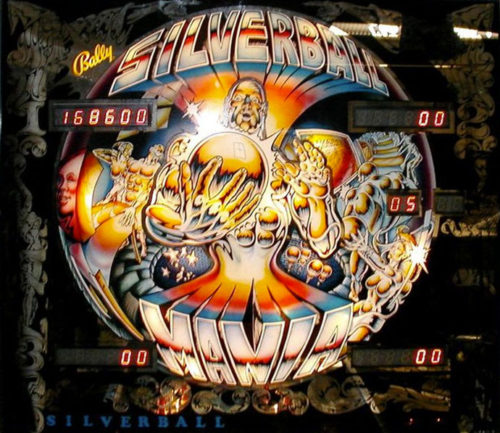 10,350 of these machines made it through the doors of Bally in 1978. Designed by the great Jim Patla and art package by Kevin O’Conner, this early wide body machine is a perfect match for the pinball trade as well as this museum. Even though it was made prior to vocalization in pinball machines, the sounds of the machine draw one in to play its features. All the technology of the 70s is present here with drop targets, loop shots, advancing bonus features and a novel kick back kicker between the flippers which, once achieved, brings the ball back into play instead of draining. Completing the spelling of “Silverball Mania” advances the bonus features. If you complete this feat three times in a game, a built in carrier feature advances on the backglass and awards an operator-adjustable reward, classically three free games. A great playfield flow was designed into the game with two “back to the top” shots enticing players along.
10,350 of these machines made it through the doors of Bally in 1978. Designed by the great Jim Patla and art package by Kevin O’Conner, this early wide body machine is a perfect match for the pinball trade as well as this museum. Even though it was made prior to vocalization in pinball machines, the sounds of the machine draw one in to play its features. All the technology of the 70s is present here with drop targets, loop shots, advancing bonus features and a novel kick back kicker between the flippers which, once achieved, brings the ball back into play instead of draining. Completing the spelling of “Silverball Mania” advances the bonus features. If you complete this feat three times in a game, a built in carrier feature advances on the backglass and awards an operator-adjustable reward, classically three free games. A great playfield flow was designed into the game with two “back to the top” shots enticing players along. -
 This contemporary machine was designed by Keith Johnson and Joe Balcer. The art package was created by Matt Groening’s cartoon team and the voices inherent in the game are from the actors who play the characters on the show. This well-designed game is basically an extension of The Simpsons TV show with all characters accounted for. Opening the garage door allows you to try and lock three balls in the couch to start couch multiball and score a jackpot or super jackpot. The three drop targets on the bottom right must be hit, the ball dropped into the hole behind them…and then repeated once more to start the Itchy and Scratchy multiball. If you’re skillful enough to complete all the modes to the basic game, the spoiler modes kick in. One of these modes reverses the flipper buttons’ function. A very complicated game enhanced by Homer following the ball around the playfield; this game is busy.
This contemporary machine was designed by Keith Johnson and Joe Balcer. The art package was created by Matt Groening’s cartoon team and the voices inherent in the game are from the actors who play the characters on the show. This well-designed game is basically an extension of The Simpsons TV show with all characters accounted for. Opening the garage door allows you to try and lock three balls in the couch to start couch multiball and score a jackpot or super jackpot. The three drop targets on the bottom right must be hit, the ball dropped into the hole behind them…and then repeated once more to start the Itchy and Scratchy multiball. If you’re skillful enough to complete all the modes to the basic game, the spoiler modes kick in. One of these modes reverses the flipper buttons’ function. A very complicated game enhanced by Homer following the ball around the playfield; this game is busy. -

-
 Claude Fernandez designed this machine at Bally with the infamous Greg Freres penning the artwork early in his career. 4,150 examples of this game were screwed together. This machine’s asymmetrical playfield is classic Bally. Lane change at the top of the playfield via flipping is a first on this machine. By dropping the targets to spell “skate”, one advances the kickout hole to advance. After three or four advances, extra ball and special light. Hitting “skate” and A and B at the bottom of the playfield light extra ball. The center drop targets advance the value of the targets when all lit, all the way to 100,000 points. If you are skillful enough to advance the bonus to its highest point, the specials light up. This Bally game is also the first machine to have seven-digit scoring!
Claude Fernandez designed this machine at Bally with the infamous Greg Freres penning the artwork early in his career. 4,150 examples of this game were screwed together. This machine’s asymmetrical playfield is classic Bally. Lane change at the top of the playfield via flipping is a first on this machine. By dropping the targets to spell “skate”, one advances the kickout hole to advance. After three or four advances, extra ball and special light. Hitting “skate” and A and B at the bottom of the playfield light extra ball. The center drop targets advance the value of the targets when all lit, all the way to 100,000 points. If you are skillful enough to advance the bonus to its highest point, the specials light up. This Bally game is also the first machine to have seven-digit scoring! -
 This April release was produced in a quantity of 4,550 units. Wayne Neyens designed the machine with Roy Parker doing the artwork. The art theme of the machine is Playboy bunnies as the Playboy Corporation opened a big Playboy club in the Chicago area in 1960 which was a real hit. The object of the game is to light the bumpers spelling out “Slick Chick.” It’s a tough game to master. Each time the sequence is completed, a rollover lights on the play field to score 10 points. If you can complete all five roll-overs, the center gobble hole lights to score a replay. Four roll-overs on the side of the play field numbered one to four also score a replay if hit in sequence. Score is your other goal toward replays. I remember playing this game at the arcades and it was very hard to achieve a winning combination. It is considered one of Wayne Neyens’ best games and one of his favorites in the annals of pinball design.
This April release was produced in a quantity of 4,550 units. Wayne Neyens designed the machine with Roy Parker doing the artwork. The art theme of the machine is Playboy bunnies as the Playboy Corporation opened a big Playboy club in the Chicago area in 1960 which was a real hit. The object of the game is to light the bumpers spelling out “Slick Chick.” It’s a tough game to master. Each time the sequence is completed, a rollover lights on the play field to score 10 points. If you can complete all five roll-overs, the center gobble hole lights to score a replay. Four roll-overs on the side of the play field numbered one to four also score a replay if hit in sequence. Score is your other goal toward replays. I remember playing this game at the arcades and it was very hard to achieve a winning combination. It is considered one of Wayne Neyens’ best games and one of his favorites in the annals of pinball design. -
 This game is the pinball rendition of the HBO TV show, The Sopranos, complete with voices of most of the actors in the series. It was designed by George Gomez with the art package created by Kevin O’Conner. The main object of the machine is to advance through the ranks of the mob by advancing your status through playfield rollovers and cracking the safe. Doing so is difficult to achieve to top capo. A multiball feature is also incorporated into the game behind a solo drop target. Video modes must be achieved to complete the placard of events culminating in the completion of your missions. So many pop bumper hits light up the party at the bing in the upper right, which scores a bunch of points. Mastering this machine is tough, but that’s what brings you back to try again.
This game is the pinball rendition of the HBO TV show, The Sopranos, complete with voices of most of the actors in the series. It was designed by George Gomez with the art package created by Kevin O’Conner. The main object of the machine is to advance through the ranks of the mob by advancing your status through playfield rollovers and cracking the safe. Doing so is difficult to achieve to top capo. A multiball feature is also incorporated into the game behind a solo drop target. Video modes must be achieved to complete the placard of events culminating in the completion of your missions. So many pop bumper hits light up the party at the bing in the upper right, which scores a bunch of points. Mastering this machine is tough, but that’s what brings you back to try again. -
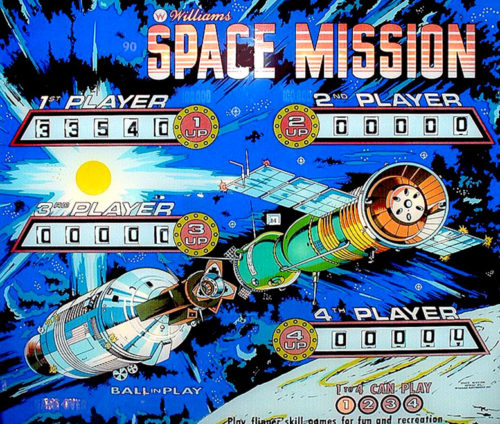 Space Mission was released in January, designed by Steve Kordek with artwork by Christian Marche. Production run was 11,652. This game was very successful for Williams and is considered to be the seventh most desirable game of the ’70s era.The game features a moving target as well as two side kickers next to the flippers for shots at the moving target. Making the A, B, or C light up the side eject holes to award a double bonus for the ball in play. If you were skillful enough to complete the A, B and C, the side outlanes light up for special. The top horshoe loop advances the bonus system. This game has a lot of nice shots and is fast paced. One doesn’t tire easily trying to achieve the scores needed to win a free game. This game was one of Steve’s Kordek’s favorite designs.
Space Mission was released in January, designed by Steve Kordek with artwork by Christian Marche. Production run was 11,652. This game was very successful for Williams and is considered to be the seventh most desirable game of the ’70s era.The game features a moving target as well as two side kickers next to the flippers for shots at the moving target. Making the A, B, or C light up the side eject holes to award a double bonus for the ball in play. If you were skillful enough to complete the A, B and C, the side outlanes light up for special. The top horshoe loop advances the bonus system. This game has a lot of nice shots and is fast paced. One doesn’t tire easily trying to achieve the scores needed to win a free game. This game was one of Steve’s Kordek’s favorite designs. -
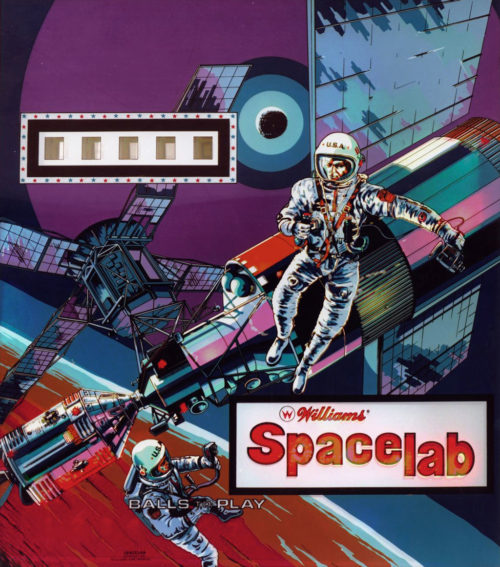
-
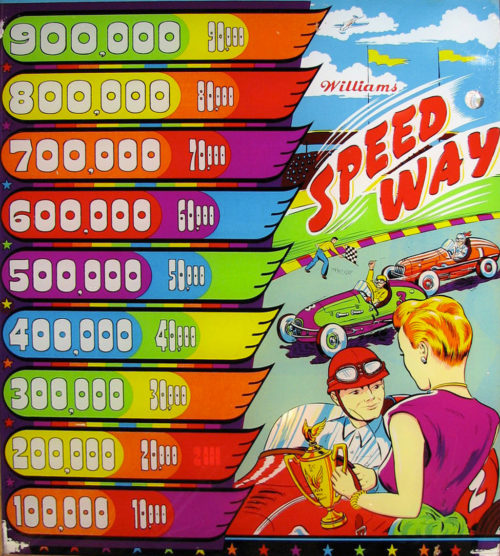
-
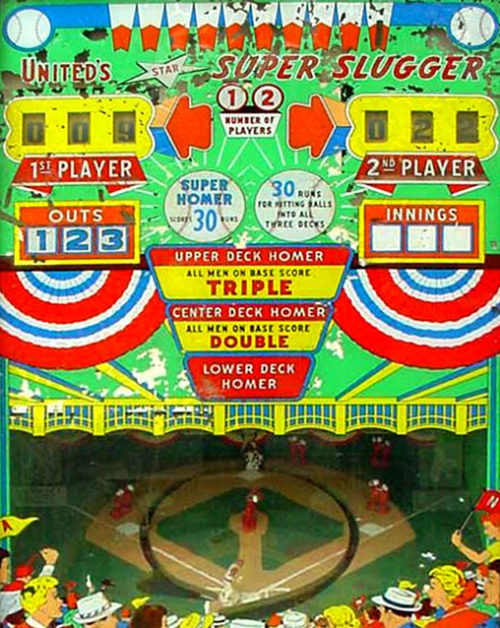 This massive baseball “pitch and bat” game is considered one of the best baseball games of its era. One or two players could play this behemoth at once, with each player alternating for three innings of play for a nickel or dime. The pitcher may randomly press one of three pitch buttons to pick a weak-to-strong pitch to the batter. The open play field allows one to try and score a home run in one of three bleachers. If you can achieve getting a homer in all three bleachers during your three outs, 30 extra runs are awarded. Then, of course, the ultimate tag of the ball would land the ball in the super home run hole, a rare achievement. This would also award 30 extra runs. Another unique feature of United baseball machines is the scoring of three singles if the ball drops in front of the ramps. These games are also notorious for having a slew of “out” holes. Batter up!
This massive baseball “pitch and bat” game is considered one of the best baseball games of its era. One or two players could play this behemoth at once, with each player alternating for three innings of play for a nickel or dime. The pitcher may randomly press one of three pitch buttons to pick a weak-to-strong pitch to the batter. The open play field allows one to try and score a home run in one of three bleachers. If you can achieve getting a homer in all three bleachers during your three outs, 30 extra runs are awarded. Then, of course, the ultimate tag of the ball would land the ball in the super home run hole, a rare achievement. This would also award 30 extra runs. Another unique feature of United baseball machines is the scoring of three singles if the ball drops in front of the ramps. These games are also notorious for having a slew of “out” holes. Batter up! -
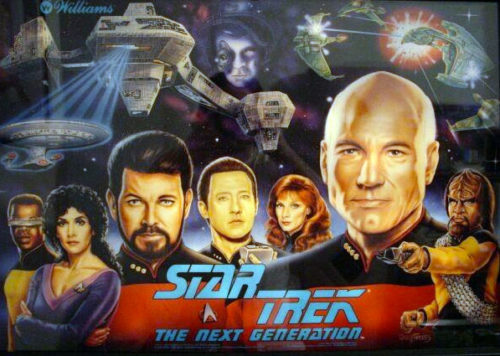 Star Trek: The Next Generation is a widebody pinball game, designed by Steve Ritchie and released in November 1993 by Williams Electronics. It was part of WMS’ SuperPin series (see also The Twilight Zone and Indiana Jones: The Pinball Adventure), and was based on the TV series. It is the only pinball machine that features three separate highscore-lists. Apart from the regular highscore-list and the buy-in-list, it also features a reminiscence to The Machine: Bride of Pin*Bot billionaires club. It is also the third pinball game overall based on the Star Trek franchise, following the 1979 pinball game by Bally, and the 1991 game by Data East (both based on the original series). Launch options When a new ball is launched into the plunger, the player is given one of five launch awards, which is selected when the ball is fired. Unless otherwise noted, the ball is launched through the spiral ramp and into the lock hole (above the pop bumpers). Another ball is popped from the left scoop and onto the left inlanes. Start Mission: Starts lit mission. Flipper Skill Shot: The player has to shoot the ball up the right ramp (the Beta Quadrant) for a random award. Launch Probe: The ball will be loaded into one of the two cannons, located on top of the slings. Shoot the lit target for a random award. If the player misses, Data will say, “The probe has discovered nothing, sir”. Light Lock / Light Holodeck: Lights the ball lock, and the ball gets locked for multiball. When this option is selected twice, “Light Lock” changes to “Light Holodeck”. Warp Factor: Starts the ball at Warp Factor 4. After the player reaches Warp 9, (depending on the ROM version), the award changes to Warp 9.1, up to 9.9 (the player has only a limited amount of time to make either the left circle or Delta ramp for each point), then changes to “Warp Factor 2″. The ball is sent to the pop bumpers. Scoring and Game Modes There are several ways to score points outside of the missions as well as unlocking certain game modes. The following modes are available: Explosive Millions – Shooting the Alpha Quadrant or Beta Quadrant ramps unlocks Explosive Millions. Shooting the same or opposite ramp awards 5 million points, followed by 10 million for another shot, which cumuliates by 10 million every shot. The player has ten seconds to hit the ramp to score or the mode ends. Bonus Multipliers – Hitting all three rollover lanes above the bumpers will increase the bonus multiplier for that ball. The first completion raises it to 2X, and subsequent steps raise it 2X at a time to a maximum of 10X. When the 8X is achieved, the Extra Ball light is lit in the “Start Mission” pocket. When the multiplier is maxed, completing the rollovers again awards 10 million, with the value increasing by 10 million every time afterward Holodeck – The player has two choices. Score 25 million points, or play the “video mode” shuttle cavern. If the player selects the video mode, the player has to go through the caverns in a shuttle, picking up 10 million point cards while avoiding mines and cavern walls. There is an extra ball card somewhere in the caverns, as well as artifact (see below). Reaching the Extra Ball is achieved by alternating Left, Left, Right, Right turns until cavern 7. Depending on how many Extra Balls have already been earned and the games Extra Ball probability configuration it may end up either an Extra Ball or a 10 million point card. Once an Extra Ball has been earned in the Holodeck all subsequent Holodeck runs will not award any Extra Balls, regardless of the path chosen. Collecting the artifact, clearing all caverns, or crashing into a mine or wall immediately ends the video mode scoring the points collected in the mode. A maximum score of 159 million points is possible for a flawless run. At the start of the Holodeck mode, pressing a flipper button along with pulling the launch trigger starts a “Riker’s Poker Night” video mode. Kickback – Shooting the three left yellow targets lights Kickback, which saves the ball from draining from the left outlane. If the game is in tournament mode this must initially be earned. Otherwise the game starts out with the Kickback lit. The Kickback can be recharged unlimited times by hitting the appropriate targets after it had been depleted. Shuttle Ramp – Each shot at the Beta Quadrant Ramp launches a shuttle which a certain number of launched shuttles can reward a player. Rewards could be Light Holodeck, Command Decision, or Extra Balls. Between the ramps are two small targets when hit, adds two times the shuttle to the counter.
Star Trek: The Next Generation is a widebody pinball game, designed by Steve Ritchie and released in November 1993 by Williams Electronics. It was part of WMS’ SuperPin series (see also The Twilight Zone and Indiana Jones: The Pinball Adventure), and was based on the TV series. It is the only pinball machine that features three separate highscore-lists. Apart from the regular highscore-list and the buy-in-list, it also features a reminiscence to The Machine: Bride of Pin*Bot billionaires club. It is also the third pinball game overall based on the Star Trek franchise, following the 1979 pinball game by Bally, and the 1991 game by Data East (both based on the original series). Launch options When a new ball is launched into the plunger, the player is given one of five launch awards, which is selected when the ball is fired. Unless otherwise noted, the ball is launched through the spiral ramp and into the lock hole (above the pop bumpers). Another ball is popped from the left scoop and onto the left inlanes. Start Mission: Starts lit mission. Flipper Skill Shot: The player has to shoot the ball up the right ramp (the Beta Quadrant) for a random award. Launch Probe: The ball will be loaded into one of the two cannons, located on top of the slings. Shoot the lit target for a random award. If the player misses, Data will say, “The probe has discovered nothing, sir”. Light Lock / Light Holodeck: Lights the ball lock, and the ball gets locked for multiball. When this option is selected twice, “Light Lock” changes to “Light Holodeck”. Warp Factor: Starts the ball at Warp Factor 4. After the player reaches Warp 9, (depending on the ROM version), the award changes to Warp 9.1, up to 9.9 (the player has only a limited amount of time to make either the left circle or Delta ramp for each point), then changes to “Warp Factor 2″. The ball is sent to the pop bumpers. Scoring and Game Modes There are several ways to score points outside of the missions as well as unlocking certain game modes. The following modes are available: Explosive Millions – Shooting the Alpha Quadrant or Beta Quadrant ramps unlocks Explosive Millions. Shooting the same or opposite ramp awards 5 million points, followed by 10 million for another shot, which cumuliates by 10 million every shot. The player has ten seconds to hit the ramp to score or the mode ends. Bonus Multipliers – Hitting all three rollover lanes above the bumpers will increase the bonus multiplier for that ball. The first completion raises it to 2X, and subsequent steps raise it 2X at a time to a maximum of 10X. When the 8X is achieved, the Extra Ball light is lit in the “Start Mission” pocket. When the multiplier is maxed, completing the rollovers again awards 10 million, with the value increasing by 10 million every time afterward Holodeck – The player has two choices. Score 25 million points, or play the “video mode” shuttle cavern. If the player selects the video mode, the player has to go through the caverns in a shuttle, picking up 10 million point cards while avoiding mines and cavern walls. There is an extra ball card somewhere in the caverns, as well as artifact (see below). Reaching the Extra Ball is achieved by alternating Left, Left, Right, Right turns until cavern 7. Depending on how many Extra Balls have already been earned and the games Extra Ball probability configuration it may end up either an Extra Ball or a 10 million point card. Once an Extra Ball has been earned in the Holodeck all subsequent Holodeck runs will not award any Extra Balls, regardless of the path chosen. Collecting the artifact, clearing all caverns, or crashing into a mine or wall immediately ends the video mode scoring the points collected in the mode. A maximum score of 159 million points is possible for a flawless run. At the start of the Holodeck mode, pressing a flipper button along with pulling the launch trigger starts a “Riker’s Poker Night” video mode. Kickback – Shooting the three left yellow targets lights Kickback, which saves the ball from draining from the left outlane. If the game is in tournament mode this must initially be earned. Otherwise the game starts out with the Kickback lit. The Kickback can be recharged unlimited times by hitting the appropriate targets after it had been depleted. Shuttle Ramp – Each shot at the Beta Quadrant Ramp launches a shuttle which a certain number of launched shuttles can reward a player. Rewards could be Light Holodeck, Command Decision, or Extra Balls. Between the ramps are two small targets when hit, adds two times the shuttle to the counter. -

-
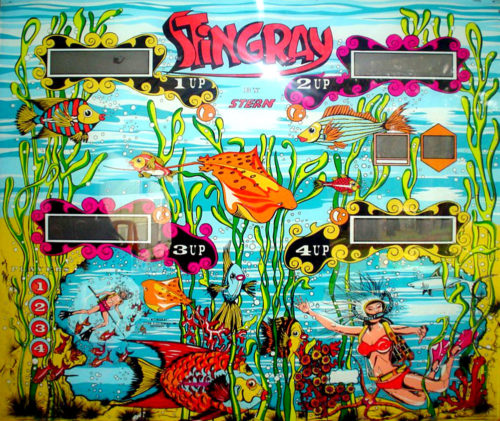 Here’s a 1977 Stern ‘Pinball’. This was Stern’s first solid state machine and marked the beginning of a long and interesting history for the company. Designed by Mike Kubin, it’s a fast game that has some wicked out-lanes and very quick ball times. There are no mini-posts above the out-lane guides which make controlling the ball near the out-lanes very difficult. Stingray, the game made by Stern following ‘Pinball’ also lacked these posts, but games made thereafter had the posts which dramatically improve the player’s ability to control the ball and avoid the out-lane. This game has a basic rule-set. Knock down the 5 drop targets twice in one ball to score the special. The saucer on the right side of the playfield awards a somewhat random award and the spinner shot on the left is a very satisfying shot to hit.
Here’s a 1977 Stern ‘Pinball’. This was Stern’s first solid state machine and marked the beginning of a long and interesting history for the company. Designed by Mike Kubin, it’s a fast game that has some wicked out-lanes and very quick ball times. There are no mini-posts above the out-lane guides which make controlling the ball near the out-lanes very difficult. Stingray, the game made by Stern following ‘Pinball’ also lacked these posts, but games made thereafter had the posts which dramatically improve the player’s ability to control the ball and avoid the out-lane. This game has a basic rule-set. Knock down the 5 drop targets twice in one ball to score the special. The saucer on the right side of the playfield awards a somewhat random award and the spinner shot on the left is a very satisfying shot to hit. -
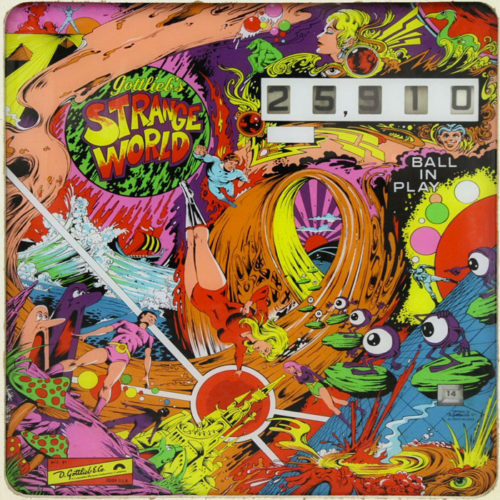
-
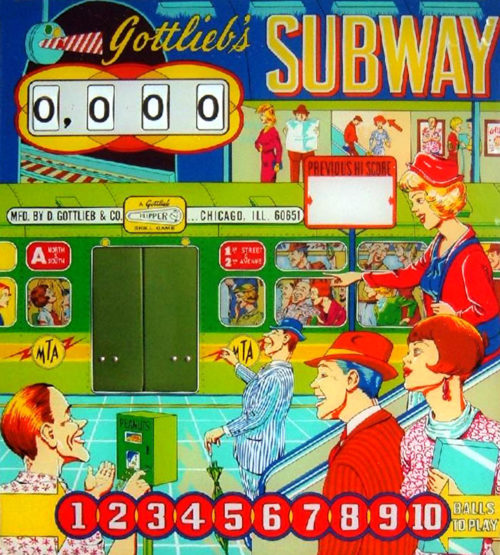 Gottlieb Subway arrived in October ’66. It was designed by the classic team of Ed Krynski and art by Gordon Morison. This add-a-ball version of the game closely resembled the replay version by the name of Crosstown. This wedgehead Gottlieb has an animated backglass. Every time 100 points are scored, the door of the subway opens, revealing passengers jammed together in a comical pose. The center target is where all the action is in the game. If you happened to match the two columns horizontally by advancing the columns by hitting various spots on the game and hit the center target, the award indicated would be given. Otherwise 10 points were awarded. This game was a tough game to play, as the opening between the flippers was rather large and a hit to the center target would regularly cost you a lost ball.
Gottlieb Subway arrived in October ’66. It was designed by the classic team of Ed Krynski and art by Gordon Morison. This add-a-ball version of the game closely resembled the replay version by the name of Crosstown. This wedgehead Gottlieb has an animated backglass. Every time 100 points are scored, the door of the subway opens, revealing passengers jammed together in a comical pose. The center target is where all the action is in the game. If you happened to match the two columns horizontally by advancing the columns by hitting various spots on the game and hit the center target, the award indicated would be given. Otherwise 10 points were awarded. This game was a tough game to play, as the opening between the flippers was rather large and a hit to the center target would regularly cost you a lost ball. -
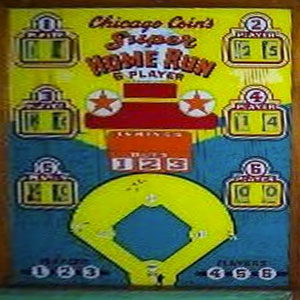
-
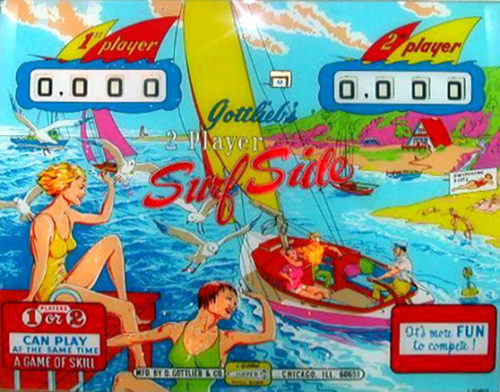 This pinball had a run of 1750 units. Designed by Ed Krynski with artwork by Art Stenholm, this 2 player four flipper game has no specials. The object of the game is to score a lot of points by advancing the yellow and red multipliers up to 100x where up to 500 points could be hit. Hitting the 100x level resets the hit column back to 1x. Extra balls are awarded if the roto spin target is hit when the star is in position. The use of the four flippers in the game makes one feels that the machine has two playfields in one. The new design pop bumpers, and auto ball lift are in early use here as well as the ball count meter. A challenging game that’s hard to beat!!!
This pinball had a run of 1750 units. Designed by Ed Krynski with artwork by Art Stenholm, this 2 player four flipper game has no specials. The object of the game is to score a lot of points by advancing the yellow and red multipliers up to 100x where up to 500 points could be hit. Hitting the 100x level resets the hit column back to 1x. Extra balls are awarded if the roto spin target is hit when the star is in position. The use of the four flippers in the game makes one feels that the machine has two playfields in one. The new design pop bumpers, and auto ball lift are in early use here as well as the ball count meter. A challenging game that’s hard to beat!!! -
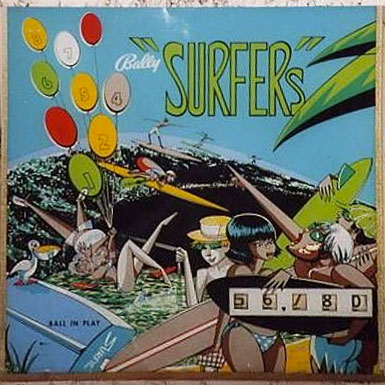
-
